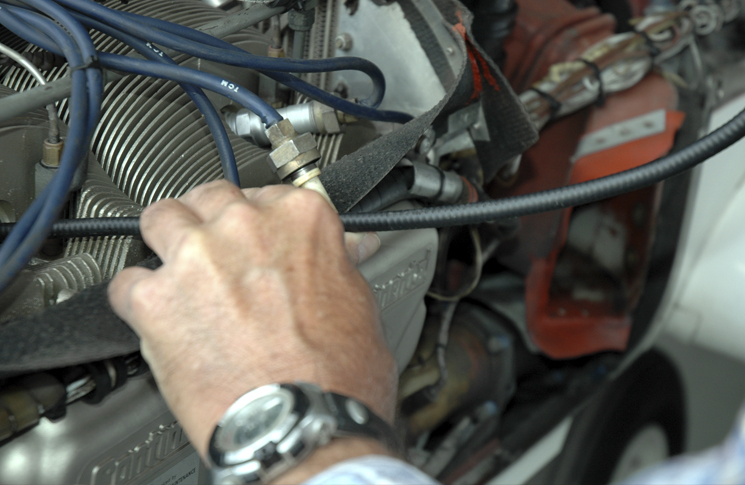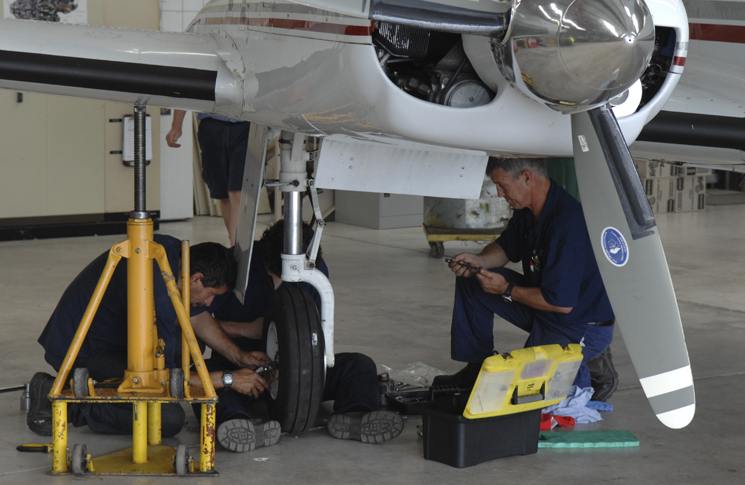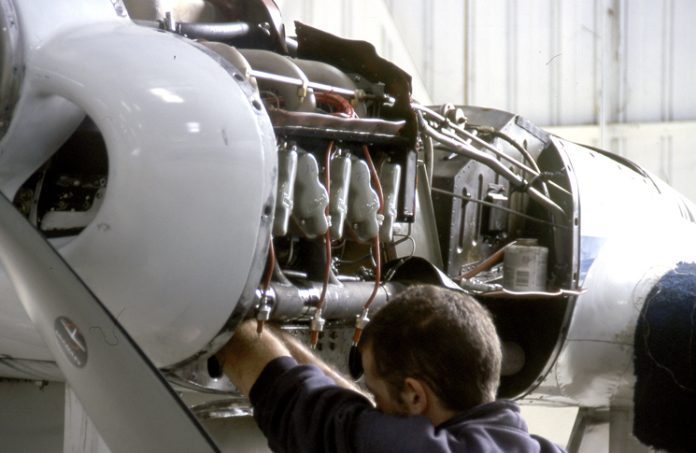As we emphasise Maintenance Month, we revisit this insightful 2019 article, shedding light on the crucial yet often overlooked aspect of aviation safety: maintenance practices. Delving into the intricacies of maintenance procedures, it serves as a timely reminder of the vital role maintenance plays in ensuring the safety and reliability of aircraft operations.
‘Never, in the history of aviation maintenance, have so many been distracted by so little.’
With apologies to Sir Winston Churchill, who was paying respect to WWII Battle of Britain air aces. The ‘so little’ I refer to in this article is that thin, slick smart phone in your pocket.
Recently I stepped through the small side door of a maintenance hangar at a regional airport and froze on the spot. Half a wingspan away was an aircraft technician leaning on the aeroplane in animated conversation, with a smart phone in his left hand, gazing into space while ratcheting out a lower rear spark plug from the engine with his right hand.
At that moment, to his complete surprise, the spark plug came out of the cylinder. His conversation suddenly became disjointed as he tried holding up his end of the conversation while doing a juggling act with the phone, socket, ratchet and spark plug.

Despite his desperate efforts, the hardware and spark plug dropped inside the cowl, rattling and rolling as they fell out on the hangar floor. The phone had won. I just turned and left, closing the door behind me.
If you are reading this on your device while actually working on an aircraft, then please take safety action immediately and step away from the aircraft—but keep reading, because you have in your hand the most disruptive device on the planet; a direct threat to your safety and to aviation safety due to the distraction it brings, and it needs to be tamed.
Very few people may remember when phones first became mobile in cars. They needed to be in a car because they were bulky and something the size of a car battery was needed for power, and a car was needed to mount the antenna

Then, one day, everything changed. A mobile phone salesman appeared at the hangar door where I was working with a group of ‘subbies’ (subcontract LAME’s) doing maintenance on a Fokker F27. The jaw-dropping thing was that he was actually carrying a mobile phone in one hand.
As memory serves, these technological marvels were equipped with an extendable antenna you could go fishing with, a full-size hand piece joined by coiled wire to a transceiver with a battery the size of a house brick and as heavy and capable of jump-starting your car. Despite the hefty price tag, he sold about five, and drove off. The dust had hardly settled when it started.
As ‘subbies’, we were always looking for the next job to try and ensure a steady income. Here was a real game changer, a phone in the hand being worth much more than two in the … (well, one at home and one in the car if you could afford it), but how could anyone call you about a job if they didn’t know your brand-new mobile phone number? It was only minutes before I heard weird one-way conversations coming from odd corners of the hanger and in the aircraft, as the excited new mobile phone owners called friends and employers to give out their new contact number.

These phones had a short battery life, had no ‘apps’, did not take pictures, could not navigate, play movies or do text messaging, and yet they were so disruptive to the work flow that the supervisor banned them from the work area within the hour.
Things sort of returned to normal, but the world was never quite the same again, because folks were now distracted, listening out for their phone to ring—which is the distraction you have while not actually having a phone distracting you (more on that later). Oh, and the phones all had exactly the same ringtone!
I didn’t realise it at the time, but I had just witnessed a once-in-a-lifetime ripple in the time-space continuum which has become a global pandemic with no signs of abating. It would be fashionable to call it a tsunami, but a tsunami recedes. Because this gateway to the universe is now in our pocket, its distractive capability looks set to continue to expand exponentially.
Distraction is a deadly enemy. While reinstalling the main fuel filter on the starboard engine of a piston twin during a 100-hourly inspection, the LAME was interrupted by another maintainer who asked for help in synchronising the magnetos on that engine. Magneto timing completed, everyone went for morning tea.
A few flight-hours later, the starboard engine caught fire in mid-air, the wing spar failed, and the fuel tank exploded. The aircraft rolled over and fell to earth as a ball of fire. I shall never forget the picture of six caskets, lids held down with the funeral parlour’s version of a brass wing nut. The LAME had been distracted. The fuel filter connection was never properly tightened, allowing highly volatile Avgas fuel to spray onto the engine as it came loose.
Today and into the future, the opportunity for distraction is much worse. We have this problem of addictive and fatal distraction from mobile phones, which is so bad that the cities of Melbourne and Sydney have embedded traffic lights in the footpath of key pedestrian crossings to try and stop downwards looking ‘phone-zombies’ from walking out into fast-moving traffic and killing themselves. What is going on?
Clinical Psychologist Dr Danielle Einstein makes three good points in her response to the question about banning smart phones in school. I only have room for two:
‘Smartphone apps and the anticipation of messages prompt dopamine release, creating addiction.’
Addiction? Correct. Addiction has many indicators such as loss of control over the amount and frequency of use, a craving and compulsive using and continued use in the face of adverse consequences. Social media engineers openly admit that their apps are deliberately designed not only to be attractive, but addictive, because the body releases dopamine with every reaction with social media, games, etc., and so you ‘need’ to be constantly connected to others via calls, texting and responding to alerts.
‘The mere presence of one’s phone consumes attention even when it’s not being checked. It’s been shown we have reduced working memory capacity and fluid intelligence when our phone is upside down, silent on our desk compared to when it is in another room,’ Einstein states.
By now you might be getting just a little defensive and think while this is true of others it’s not true of you. Perhaps you would like to argue that the phone is your source of approved data for doing the job. This may be true, but does anyone think they can use their phone undetected? Every call and internet access logs an exact time date and data provider. An accident investigation could easily discover when a mobile phone was used and for what, and a case for neglect of duty of care due to phone distraction could be proven to have existed.
Trying to tame smartphone addiction can be quite difficult and there are some complex and comprehensive phone usage policies around, but I think the simplest is the best. Treat the hangar as a sterile environment. If working solo (the very time you think you will need it the most) either put the phone in a separate location from where you are working or turn it off, so that you are not tempted to pick up whenever it rings, or to fill in those boring moments when doing something that you have done many times before.
Are you suffering the beginnings of phone separation anxiety as you read that? Sorry but it seems you may well be addicted.
Again, an aircraft owner-operator might want to visit and observe a prospective maintenance organisation’s mobile phone policy. They probably don’t want to be paying for things like, well, lost time due to social media usage and dropped spark plugs.
Oh yes, and before I go, just the one question: Hands up all those who want to fly in an aircraft subjected to phoney maintenance?
I see no hands. (With apologies to Lord Nelson and his blind eye)






Terrific!! Well written, to the point and soooo timely!!!!
Amazing article!
Hmmm… on one hand I agree with the sterile hangar idea, on the other hand, particularly for someone working alone, a mobile phone is a safety device that would be essential if some harm came to a person working alone… those working on aircraft just need to be more aware of the distraction impact and revisit the job they were doing BEFORE the distraction… given the tragic circumstances you mention was caused by another member of the maintenance team rather than a mobile phone, perhaps have a requirement that you don’t distract a colleague in the middle of a job… perhaps the magneto synchronisation could have waited… both jobs were critical, but I doubt they both had to be done that urgently that one couldn’t have waited…